Associate VP of Undergraduate Enrollment speaks about admissions process
After admitting 3,446 students last year for a record low acceptance rate of 14.6%, Notre Dame continues to be one of the most selective universities in the country. Again this fall, thousands of high school seniors across the globe submitted their restrictive early applications to the University of Notre Dame in hopes to be offered admission in mid-December. Don Bishop, Associate Vice President for Undergraduate Enrollment at the University of Notre Dame, shared with the Rover the goals and changes within the admissions department over the years, and spoke about what the university is looking for in its prospective students.
Diversity
In recent years, Notre Dame, along with many elite universities, has begun not only re-examining the type of student they admit but also working on expanding the pool of who is applying. They have done this in an attempt to make the student population mirror demographic shifts in the nation. Don Bishop explained that attracting demographics which have not typically been prominent at Notre Dame requires out-reach on the part of the admissions department. He questioned previous efforts, asking, “Were we out there recruiting students? Or were we waiting for students to just know Notre Dame and apply?”
Bishop, citing the need to reach out to more diverse student populations, remarked that at some point, “the leadership of the university made the executive decision that Notre Dame ought to get into the game [of extensive marketing and recruiting] that’s been played by everybody else.” Bishop claimed that this new emphasis on proactive outreach, especially towards minorities, led to a 63% increase in applications since 2010.
This new, more proactive approach to admissions and student outreach rests upon the goal of making Notre Dame more accessible to all demographic groups while also providing Notre Dame students with a diverse educational experience.
Bishop asked, “Do we have enough international students to provide a worldview? Do we have enough low income students that that view of life is seen and understood here both in the hall life but also in the academic life at Notre Dame?”
He continued, “We look at the end of the year at whether our distribution is mirroring what’s going on in America.” While being influenced by the statistical trends of the country, Bishop further explained that, “We’re not about quotas … we’re not just trying to distribute the class based upon some demographic.”
Catholic Identity
When discussing why Notre Dame’s racial distribution does not match the nationwide demographics and trends of other private universities, Bishop explained, “There’s this natural Catholic aspiring pool that has been encouraged to look at Notre Dame,” alluding to the fact that the university’s demographics may more closely resemble those of the Church in America than the nation itself.
Bishop spoke in depth about the Catholic identity of the school as well as the advantage this may bring in recruiting students: “We benefit from being seen as and committed to being the leading Catholic university in the United States. We have continued to support that in our marketing and recruitment efforts.”
He continued, stating that of the Catholics in the top 1% of test scores in the nation, “over half of those students apply to Notre Dame.” Considering its role as the top Catholc university in the United States, Bishop spoke in depth about the importance of recruiting Catholic students. He said that the admissions department always tries to make sure that “every top Catholic in America had a full conversation about Notre Dame with Notre Dame. And if that hasn’t happened, we ought to make sure that becomes true.”
While unapologetic of the Catholic identity of the university and focused on recruiting top Catholic students, Bishop also spoke about the decision to no longer publish the percentage of Catholics in each incoming class in official Notre Dame admissions publications: “The market feedback is if you publish that you’re telling non-Catholics they’re not welcomed. That was never, ever implied. But it’s being perceived more and more.”
While the information is not officially published by the admissions office, Bishop told the Rover that the student body is 80% Catholic; he added, “During my entire time here, it’s been almost the exact same percent.”
In further discussion of the Catholic identity of the school, Bishop raised concerns about portraying the university as “too Catholic.” He told the Rover that his worry is that a top Catholic student might question, “I could go to Princeton, I could go to Cornell; is Notre Dame too Catholic? Is Notre Dame going to provide me enough?”
Bishop explained the concern that “top Catholics will not apply to Notre Dame or even consider Notre Dame unless they think we’re a diverse enough environment. Because they intend to be a leader of the world, not just the Catholic world.”
When asked if he is concerned about the perception that the university is perhaps not Catholic enough Bishop said: “I don’t know. For anybody that wants to argue that 80% means we’re no longer Catholic, I don’t know how to talk to you now. I don’t know if I’m interested in your argument.” Rather than focusing on how Catholic the student body is, Bishop concluded, “I think that long term Notre Dame needs to be focused on the mission.”
Mission
Bishop elaborated on what he meant by “focused on the mission.” “As we look at each applicant, we ask if this student seems to represent in their application a real desire to live to the Notre Dame standard, to seek out the Notre Dame value system,” he said.
Bishop explained that the first question the department asks when reviewing applications with respect to this value system is, “Does this applicant take pride in giving more of their life than what they take from others?”
In a November 6 admissions session for visiting high school students and parents, Bishop elaborated on the utility of the Catholic mission of the university: “I think that our focus is on you being happy, the happier you are, the more effective you’re going to be for others,” Bishop stated. “I think Notre Dame people are more generous, we’re a little bit more balanced. And I think that Catholic nature really helps you and us with that.”
In his pitch to the high-schoolers on the benefits of a faith-centered education, Bishop said, “Notre Dame makes it [spirituality] easy and comfortable. We don’t try to tell you what to do. But we make everything available for you to do, we try to make it attractive.”
Provost Marie Lynn Miranda echoed a similar message in an interview with the Rover this fall. When asked if the university attempts to put forward any vision of the good to its students and faculty she said, “So, I think it’s an interesting question. I don’t think so, but you might talk to some other people.” She continued, “I would say it’s more that there are all these different pathways for people to go down to live a life that is meaningful and purposeful and faithful.”
Bishop elaborated on the Catholic identity of the school to the families in attendance on November 6: “My liberal Catholics feel that Notre Dame is too conservative, my conservative Catholics feel we’re just a liberal institution. We’re ticking everybody off here. My instinct is if you’re somewhere in the middle and both sides are banging on you, maybe that’s not a bad place.”
Early decision acceptance for the class of 2026 will be shared in the coming weeks, with regular decisions announced in the spring.
Nico Schmitz is a sophomore originally from Pasadena, CA now living in Cleveland, OH. He is majoring in the Program of Liberal Studies, but he spends most of his time wondering how he got into Notre Dame. If you are hoping to be as fortunate, email him at nschmit2@nd.edu
W. Joseph DeReuil is a sophomore from St. Paul, MN studying philosophy, classics, and constitutional studies. He also spends significant time wondering how Nico got into Notre Dame. If you have similar concerns, please contact him at wdereuil@nd.edu
Photo credit: University of Notre Dame Enrollment Division
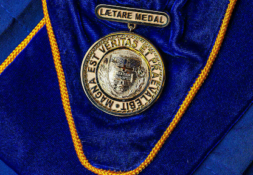
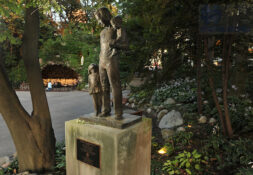
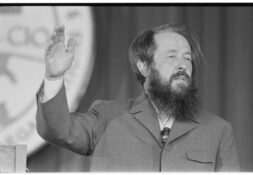
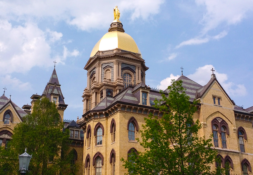
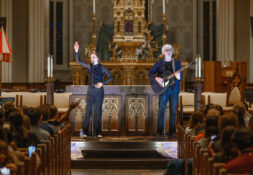

Leave a Reply